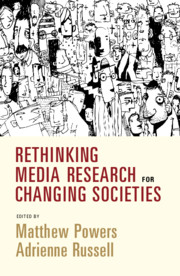Book contents
- Rethinking Media Research for Changing Societies
- Communication, Society and Politics
- Rethinking Media Research for Changing Societies
- Copyright page
- Contents
- Figure
- Contributors
- Acknowledgments
- 1 Introduction
- Part I Living in a Datafied World
- Part II Journalism in Times of Change
- Part III Media and Problems of Inclusion
- 7 Journalism and Inclusion
- 8 Afrotechtopolis
- 9 Exploiting Subalternity in the Name of Counter-Hegemonic Communication
- Part IV Engagement with and through Media
- Part V The Role of Scholars
- Other Books in the Series (continued from page ii)
- References
8 - Afrotechtopolis
How Computing Technology Maintains Racial Order
from Part III - Media and Problems of Inclusion
Published online by Cambridge University Press: 18 September 2020
- Rethinking Media Research for Changing Societies
- Communication, Society and Politics
- Rethinking Media Research for Changing Societies
- Copyright page
- Contents
- Figure
- Contributors
- Acknowledgments
- 1 Introduction
- Part I Living in a Datafied World
- Part II Journalism in Times of Change
- Part III Media and Problems of Inclusion
- 7 Journalism and Inclusion
- 8 Afrotechtopolis
- 9 Exploiting Subalternity in the Name of Counter-Hegemonic Communication
- Part IV Engagement with and through Media
- Part V The Role of Scholars
- Other Books in the Series (continued from page ii)
- References
Summary
This chapter examines the way digital technologies reinforce racialized social hierarchies. Charlton McIlwain argues that cultural histories of the internet typically exclude black history, and that such an oversight makes it difficult to grasp how racial representations and institutional structures have long-shaped computing systems. Sketching a history that extends back at least to the 1960s, he shows that governments and corporations have long sought to develop technologies that would thwart any attempts at challenging racialized hierarchies and that such efforts can be seen today, as in the revelation that IBM used New York Police Department surveillance footage to develop technology that uses skin color to search for criminal suspects. He argues that any effort to challenge racialized social hierarchies have to consider the technological grounds on which their struggles are waged. While acknowledging that digital tools have been immensely useful for recent movements like Black Lives Matter, he argues that any effort to address technologically enabled racialized hierarchies, which he terms “Afrotechtopolis,” must develop its own technologies.
- Type
- Chapter
- Information
- Rethinking Media Research for Changing Societies , pp. 105 - 118Publisher: Cambridge University PressPrint publication year: 2020
References
- 1
- Cited by

